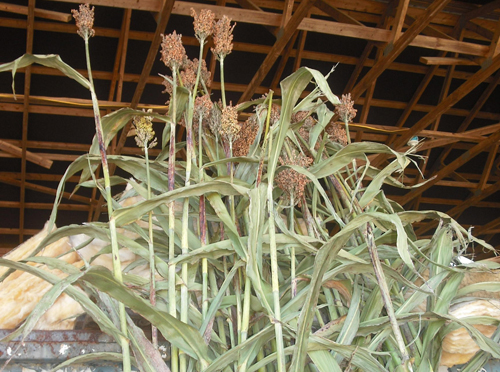Is sorghum molasses sweet and flavorsome for you, or is it a syrup that is sticky and sinister? Although I only occasionally eat sorghum molasses, I’m sure that I would have learned how to make it if I had grown up on a farm. It was syrup that my father grew up eating regularly, and throughout adulthood he ate it as part of his daily supper — only his was bought in a store.
Sorghum molasses is a rich, brown, sweet, thick syrup. Enjoying it with hot biscuits at breakfast is a tradition in North Carolina. Sorghum molasses is also used on pancakes and hot cereals such as grits, and the syrup can be used as a sweetener in baking and cooking. Because most sorghum varieties are heat-tolerant, they once were very important for poor and rural people. Many in our state grew up with sorghum as a sweetener when refined sugar was not readily available or affordable.
Sorghum is a species of grass grown commonly as a fodder plant and for grain. Sweet sorghum – one of the varieties of sorghum that has a high sugar content — is also grown for syrup production. Introduced into the United States from Africa, sorghum has been widely cultivated in North Carolina and other parts of the American South since the 1850s, although sorghum is not grown as frequently as it once was. In fact, sorghum syrup is harder to find than other syrups, and only a few family-owned farms in the South still operate sorghum cane mills.
When the Charles Martin Farm in Jackson Springs, a small community in Moore County, invited the public to an “old-fashioned” demonstration, I jumped at the opportunity to see the process. First, the tall canes are cut and stripped of leaves. A worker feeds the stalks a few at a time into a roller mill, which traditionally was pulled by a horse or mule. As the stalks go through the mill, rollers extract a green juice by crushing the stalks. Next the juice is concentrated and purged of impurities by being boiled in a wood-fired evaporator pan. Even after the boiling process, the juice — now brown — still retains most of its nutrients and sugars. When it develops a thick, honey-like consistency, a metal ladle is used to transfer the syrup into a glass container. (If the syrup is still cloudy-looking, then it is not ready.)
When I visited the Martin Farm, where sorghum molasses is made annually as a traditional family craft, I was one of the few spectators even though local print and broadcast media had publicized the event. Most of the spectators seem to be friends from neighboring areas who were joining again in a annual community activity.
Because making syrup is very labor-intensive, its production has fallen drastically since World War II. North Carolina is one of the few states where sorghum is still grown for syrup production. In middle to late October our state still has festivals that celebrate the sorghum harvest such as the events in Caldwell County and Sampson Country. A previous generation would have told us that sorghum molasses is not only charming and flavorsome but nutritious as well. Perhaps we are missing an opportunity to come together and socialize as a community because sorghum molasses rarely has a place on our kitchen tables.
Source: Sorghum Molasses: A Tradition Worth Preserving – NC Folklife Institute


